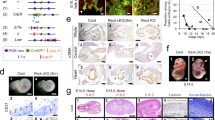Abstract
The extracellular matrix (ECM) acts as a critical factor during morphogenesis. Because the organization of the ECM directly influences the structure of tissues and organs, a determination of the way that ECM organization is regulated should help to clarify morphogenesis. We have analyzed the assembly of Del1, an ECM protein produced by endothelial cells in embryos, in the ECM. Del1 consists of three epidermal growth factor repeats (E1–E3) at its N-terminus and two discoidin domains (C1, C2) at its C-terminus. Experiments with various deletion mutants of Del1 have revealed that fragments containing the C-terminus of C1, which has a lectin-like structure, direct deposition in the ECM. The efficiency of deposition varies according to the presence of other domains in Del1. A fragment containing E3 and C1 has the strongest deposition activity, whereas fragments containing C2, which is highly homologous to C1, have low deposition activity. Digestion of ECM with hyaluronidase from bovine testis releases Del1 from the ECM, suggesting that glycosaminoglycans are involved in the deposition of Del1. In vivo gene transfer experiments have shown that fusion with the deposition domain of Del1 dramatically alters the distribution of exogenous proteins in mice. Thus, the extent of Del1 deposition may modify the organization of the ECM.








Similar content being viewed by others
References
Andersen MH, Graversen H, Fedosov SN, Petersen TE, Rasmussen JT (2000) Functional analyses of two cellular binding domains of bovine lactadherin. Biochemistry 39:6200–6206
Aoka Y, Johnson FL, Penta K, Hirata Ki K, Hidai C, Schatzman R, Varner JA, Quertermous T (2002) The embryonic angiogenic factor Del1 accelerates tumor growth by enhancing vascular formation. Microvasc Res 64:148–161
Baumgartner S, Hofmann K, Chiquet-Ehrismann R, Bucher P (1998) The discoidin domain family revisited: new members from prokaryotes and a homology-based fold prediction. Protein Sci 7:1626–1631
Hanayama R, Tanaka M, Miwa K, Nagata S (2004) Expression of developmental endothelial locus-1 in a subset of macrophages for engulfment of apoptotic cells. J Immunol 172:3876–3882
Hidai C, Zupancic T, Penta K, Mikhail A, Kawana M, Quertermous EE, Aoka Y, Fukagawa M, Matsui Y, Platika D, Auerbach R, Hogan BL, Snodgrass R, Quertermous T (1998) Cloning and characterization of developmental endothelial locus-1: an embryonic endothelial cell protein that binds the alphavbeta3 integrin receptor. Genes Dev 12:21–33
Hidai C, Kawana M, Habu K, Kazama H, Kawase Y, Iwata T, Suzuki H, Quertermous T, Kokubun S (2005) Overexpression of the Del1 gene causes dendritic branching in the mouse mesentery. Anat Rec 287:1165–1175
Kadler KE, Hojima Y, Prockop DJ (1987) Assembly of collagen fibrils de novo by cleavage of the type I pC-collagen with procollagen C-proteinase. Assay of critical concentration demonstrates that collagen self-assembly is a classical example of an entropy-driven process. J Biol Chem 262:15696–15701
Kim SW, Quinn-Allen MA, Camp JT, Macedo-Ribeiro S, Fuentes-Prior P, Bode W, Kane WH (2000) Identification of functionally important amino acid residues within the C2-domain of human factor V using alanine-scanning mutagenesis. Biochemistry 39:1951–1958
Kittur FS, Manithody C, Morrissey JH, Rezaie AR (2004) The cofactor function of the N-terminal domain of tissue factor. J Biol Chem 279:39745–39749
Knobe KE, Persson KE, Sjorin E, Villoutreix BO, Stenflo J, Ljung RC (2003) Functional analysis of the EGF-like domain mutations Pro55Ser and Pro55Leu, which cause mild hemophilia B. J Thromb Haemost 1:782–790
Li S, Van Den Diepstraten C, D’Souza SJ, Chan BM, Pickering JG (2003) Vascular smooth muscle cells orchestrate the assembly of type I collagen via alpha2beta1 integrin, RhoA, and fibronectin polymerization. Am J Pathol 163:1045–1056
Macedo-Ribeiro S, Bode W, Huber R, Quinn-Allen MA, Kim SW, Ortel TL, Bourenkov GP, Bartunik HD, Stubbs MT, Kane WH, Fuentes-Prior P (1999) Crystal structures of the membrane-binding C2 domain of human coagulation factor V. Nature 402:434–439
Miyahara M, Njieha FK, Prockop DJ (1982) Formation of collagen fibrils in vitro by cleavage of procollagen with procollagen proteinases. J Biol Chem 257:8442–8448
Ohlin AK, Landes G, Bourdon P, Oppenheimer C, Wydro R, Stenflo J (1988) Beta-hydroxyaspartic acid in the first epidermal growth factor-like domain of protein C. Its role in Ca2+ binding and biological activity. J Biol Chem 263:19240–19248
Penta K, Varner JA, Liaw L, Hidai C, Schatzman R, Quertermous T (1999) Del1 induces integrin signaling and angiogenesis by ligation of alphaVbeta3. J Biol Chem 274:11101–11109
Persson KE, Villoutreix BO, Thamlitz AM, Knobe KE, Stenflo J (2002) The N-terminal epidermal growth factor-like domain of coagulation factor IX. Probing its functions in the activation of factor IX and factor X with a monoclonal antibody. J Biol Chem 277:35616–35624
Rees DJ, Jones IM, Handford PA, Walter SJ, Esnouf MP, Smith KJ, Brownlee GG (1988) The role of beta-hydroxyaspartate and adjacent carboxylate residues in the first EGF domain of human factor IX. EMBO J 7:2053–2061
Ruhrberg C, Gerhardt H, Golding M, Watson R, Ioannidou S, Fujisawa H, Betsholtz C, Shima DT (2002) Spatially restricted patterning cues provided by heparin-binding VEGF-A control blood vessel branching morphogenesis. Genes Dev 16:2684–2698
Sakai T, Larsen M, Yamada KM (2003) Fibronectin requirement in branching morphogenesis. Nature 423:876–881
Sottile J, Hocking DC (2002) Fibronectin polymerization regulates the composition and stability of extracellular matrix fibrils and cell-matrix adhesions. Mol Biol Cell 13:3546–3559
Watanabe T, Totsuka R, Miyatani S, Kurata S, Sato S, Katoh I, Kobayashi S, Ikawa Y (2005) Production of the long and short forms of MFG-E8 by epidermal keratinocytes. Cell Tissue Res 321:185–193
Zhong J, Eliceiri B, Stupack D, Penta K, Sakamoto G, Quertermous T, Coleman M, Boudreau N, Varner JA (2003) Neovascularization of ischemic tissues by gene delivery of the extracellular matrix protein Del-1. J Clin Invest 112:30–41
Author information
Authors and Affiliations
Corresponding author
Rights and permissions
About this article
Cite this article
Hidai, C., Kawana, M., Kitano, H. et al. Discoidin domain of Del1 protein contributes to its deposition in the extracellular matrix. Cell Tissue Res 330, 83–95 (2007). https://doi.org/10.1007/s00441-007-0456-9
Received:
Accepted:
Published:
Issue Date:
DOI: https://doi.org/10.1007/s00441-007-0456-9




